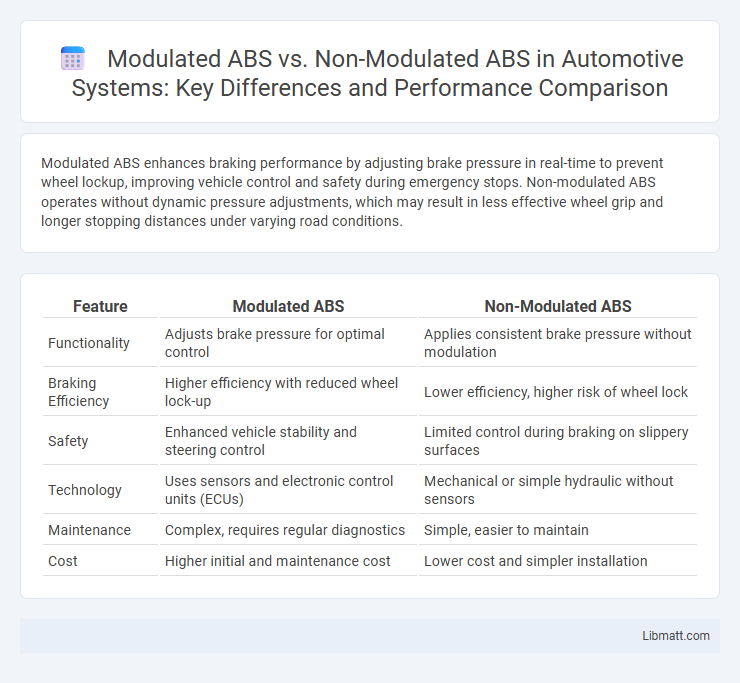Modulated ABS enhances braking performance by adjusting brake pressure in real-time to prevent wheel lockup, improving vehicle control and safety during emergency stops. Non-modulated ABS operates without dynamic pressure adjustments, which may result in less effective wheel grip and longer stopping distances under varying road conditions.
Table of Comparison
| Feature | Modulated ABS | Non-Modulated ABS |
|---|---|---|
| Functionality | Adjusts brake pressure for optimal control | Applies consistent brake pressure without modulation |
| Braking Efficiency | Higher efficiency with reduced wheel lock-up | Lower efficiency, higher risk of wheel lock |
| Safety | Enhanced vehicle stability and steering control | Limited control during braking on slippery surfaces |
| Technology | Uses sensors and electronic control units (ECUs) | Mechanical or simple hydraulic without sensors |
| Maintenance | Complex, requires regular diagnostics | Simple, easier to maintain |
| Cost | Higher initial and maintenance cost | Lower cost and simpler installation |
Introduction to ABS Technology
Anti-lock Braking System (ABS) technology prevents wheel lock-up during braking by modulating brake pressure to maintain traction and control. Modulated ABS continuously adjusts hydraulic pressure to optimize braking force, enhancing vehicle stability and reducing stopping distances compared to non-modulated ABS, which lacks this dynamic control. Your understanding of these differences is crucial for recognizing the impact on safety and braking performance in various driving conditions.
What is Modulated ABS?
Modulated ABS refers to an advanced anti-lock braking system that dynamically adjusts brake pressure to prevent wheel lockup during sudden stops. Unlike non-modulated ABS, which applies consistent pressure to maintain traction, modulated ABS continuously modulates braking force based on real-time sensor data. Your vehicle benefits from improved control and shorter stopping distances with modulated ABS, enhancing overall driving safety.
What is Non-Modulated ABS?
Non-modulated ABS, also known as conventional ABS, operates by delivering a continuous, unvarying brake pressure during wheel lock prevention without automatic fluctuations. This system lacks the fine hydraulic modulation found in modulated ABS, resulting in less precise control over brake pressure and potentially longer stopping distances on varying road surfaces. Non-modulated ABS typically reduces wheel lock but may not optimize traction and stability as effectively as modulated ABS systems.
Key Differences Between Modulated and Non-Modulated ABS
Modulated ABS continuously adjusts braking pressure based on wheel slip, providing enhanced control and shorter stopping distances, while non-modulated ABS applies a fixed pressure without real-time adjustments, often resulting in less optimized braking performance. Modulated ABS systems use sensors and electronic control units (ECUs) to dynamically modulate brake force, improving stability and reducing the risk of wheel lockup under varying road conditions. Non-modulated ABS typically relies on mechanical or simpler hydraulic control, lacking the sophistication to respond swiftly to changes in traction.
Performance Comparison: Modulated vs. Non-Modulated ABS
Modulated ABS provides superior braking performance by dynamically adjusting brake pressure to prevent wheel lockup, enhancing vehicle stability and control during emergency stops compared to non-modulated ABS systems that apply constant pressure. Non-modulated ABS often results in longer stopping distances and less effective traction management on varying road surfaces. Studies show modulated ABS reduces skid incidents and improves overall safety metrics, especially in adverse driving conditions.
Safety Implications of ABS Types
Modulated ABS continuously adjusts brake pressure to prevent wheel lockup, enhancing vehicle stability and control during emergency stops. Non-modulated ABS applies braking force without pressure modulation, increasing the risk of skidding and longer stopping distances on slippery surfaces. Your safety is significantly improved with modulated ABS due to its ability to optimize traction and reduce accident likelihood in critical braking situations.
Applications in Automotive and Motorcycle Sectors
Modulated ABS offers enhanced control and reduced stopping distances by dynamically adjusting brake pressure, making it ideal for high-performance motorcycles and advanced automotive braking systems. Non-modulated ABS provides basic anti-lock functionality, primarily used in entry-level vehicles and motorcycles to prevent wheel lock-up under hard braking. Automotive manufacturers increasingly favor modulated ABS for its adaptability in varied road conditions, while non-modulated ABS remains common in cost-sensitive markets and simpler motorcycle models.
Cost and Maintenance Considerations
Modulated ABS systems generally incur higher initial costs due to advanced electronic components and sensors compared to non-modulated ABS, which utilizes simpler mechanical components. Maintenance for modulated ABS often requires specialized diagnostic tools and trained technicians, increasing service expenses, whereas non-modulated ABS systems involve more straightforward upkeep and lower repair costs. Over time, the durability and performance efficiency of modulated ABS can reduce long-term maintenance expenses despite the higher upfront investment.
User Experience and Feedback
Modulated ABS enhances user experience by providing smoother brake modulation and improved control, reducing wheel lock-up compared to non-modulated ABS. Feedback from users consistently highlights increased confidence and stability during emergency braking situations with modulated systems. Non-modulated ABS often results in harsher pedal feel and less precise braking control, leading to decreased driver confidence.
Which ABS is Better for Your Vehicle?
Modulated ABS offers superior braking control by adjusting brake pressure in real-time, reducing wheel lockup more effectively than non-modulated ABS, which applies constant pressure once activated. Vehicles equipped with modulated ABS benefit from enhanced stability and shorter stopping distances, especially in slippery or emergency conditions. Non-modulated ABS, while simpler and less costly, may not provide the same level of precision and safety, making modulated ABS generally the better choice for modern vehicles.
modulated ABS vs non-modulated ABS Infographic

 libmatt.com
libmatt.com